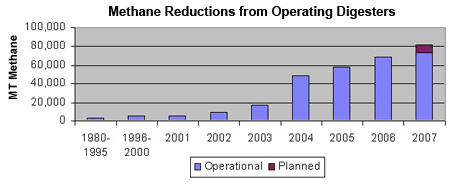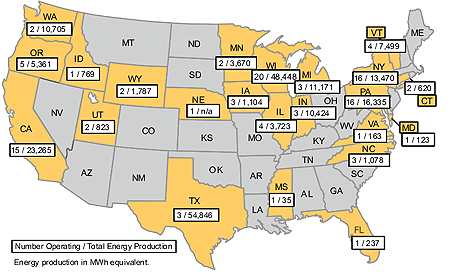 Accomplishments Accomplishments
The AgSTAR Program has been very successful in encouraging the
development and adoption of anaerobic digestion technology. Since the
establishment of the program in 1994, the number of operational
digester systems has grown to more than 111 systems across the United
States. This growth has produced significant environmental and energy
benefits, including in 2007 alone, approximately 215
million kWh equivalent of energy generation. The graph below shows the historical use of biogas
recovery technology for animal waste management.
Financial incentives have increased the deployment rate of manure
digester systems. For example, grants and loans awarded by USDA Rural
Development  through the Farm Bill have been one of the primary methods for farms to
partially fund installation of commercially proven livestock waste
digestion technologies. Since 2003, USDA Rural Development has awarded
more than $40 million for anaerobic digestion systems. through the Farm Bill have been one of the primary methods for farms to
partially fund installation of commercially proven livestock waste
digestion technologies. Since 2003, USDA Rural Development has awarded
more than $40 million for anaerobic digestion systems.

2007 Operating Manure Digesters

The development of anaerobic digesters for livestock manure treatment
and energy production has accelerated at a very fast pace over the past
few years. Factors influencing this market demand include: increased
technical reliability of anaerobic digesters through the deployment of
successful operating systems over the past five years; growing concern
of farm owners about environmental quality; an increasing number of
state and federal programs designed to cost share in the development of
these systems; increasing energy costs and the desire for energy
security; and the emergence of new state energy policies (such as net
metering legislation) designed to expand growth in reliable renewable
energy and green power markets.
|

